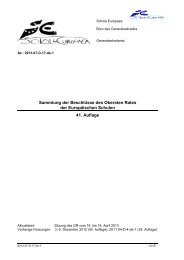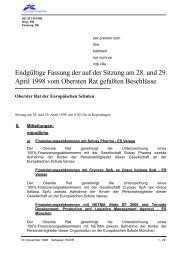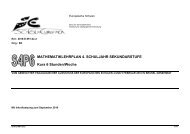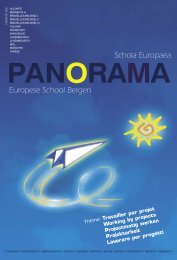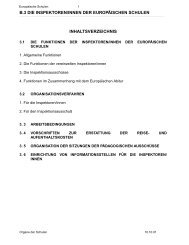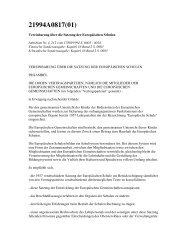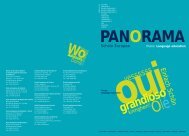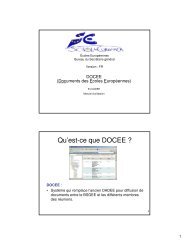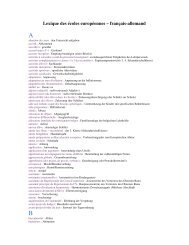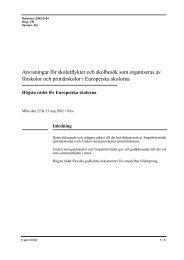External Evaluation of the European Baccalaureate (Annexes)
External Evaluation of the European Baccalaureate (Annexes)
External Evaluation of the European Baccalaureate (Annexes)
Create successful ePaper yourself
Turn your PDF publications into a flip-book with our unique Google optimized e-Paper software.
The level in each part is not as elevated as similar elements in <strong>the</strong> French Bac. But, on <strong>the</strong> o<strong>the</strong>r hand,<br />
some parts are more developed in France (for example, Complex numbers).<br />
The objectives seem to be clearer in EB, principally because <strong>the</strong>ir presentation is simpler and more<br />
precise.<br />
The first column in <strong>the</strong> French specification is similar in form to <strong>the</strong> second element in <strong>the</strong> EB curriculum.<br />
On <strong>the</strong> o<strong>the</strong>r hand, <strong>the</strong>re is nothing like <strong>the</strong> third column (remarks) <strong>of</strong> <strong>the</strong> French text in <strong>the</strong> EB syllabus.<br />
The presentation <strong>of</strong> EB syllabus is reminiscent <strong>of</strong> <strong>the</strong> presentation <strong>of</strong> <strong>the</strong> French curriculum in <strong>the</strong> 1970s.<br />
On content:<br />
Broadly, <strong>the</strong> same parts <strong>of</strong> ma<strong>the</strong>matics are studied in both formations.<br />
It is difficult to determine, from reading <strong>the</strong> specification alone, exactly what level <strong>of</strong> outcome is expected<br />
<strong>of</strong> students. In <strong>the</strong> explanation within <strong>the</strong> EB syllabus, <strong>the</strong>re is a part about assessment: 1) general<br />
principles; 2) written examinations; 3) <strong>the</strong> baccalaureate; 4) content <strong>of</strong> <strong>the</strong> written examination 5) permitted<br />
material; 6) criteria for correction and marks awarded. In France, <strong>the</strong>se details are given in a precise form<br />
in a specific text.<br />
In conclusion, on <strong>the</strong> basis <strong>of</strong> similar texts, EB carries <strong>the</strong> possibility <strong>of</strong> more personal interpretations <strong>of</strong><br />
requirement and content than <strong>the</strong> French text. It is interesting that law about <strong>the</strong> future <strong>of</strong> education (2005)<br />
in France asserts this new notion <strong>of</strong> increased autonomy.<br />
2. The assessment itself<br />
2.1. French bac:<br />
The conditions <strong>of</strong> bac S are presented in an additional text to <strong>the</strong> syllabus. Precise details about <strong>the</strong><br />
level <strong>of</strong> outcome required are given in this second text.<br />
For example, in ‘Objectives <strong>of</strong> test’:<br />
To acquire knowledge and to organize <strong>the</strong>m<br />
To mobilize notions, results and methods to solve a ma<strong>the</strong>matical problem<br />
To take initiative<br />
To understand and to build an argument<br />
To get a comprehensible form to a solution or a demonstration.<br />
The separation <strong>of</strong> <strong>the</strong>se into a separate document may be a disadvantage in terms <strong>of</strong> teacher awareness.<br />
Content <strong>of</strong> <strong>the</strong> written examination (4 h): <strong>the</strong> question paper comprises between 3 and 5 exercises,<br />
marked between 3 and 10, in relation to a global notation <strong>of</strong> 20.<br />
2008 session<br />
Four exercises: marked 5 points.<br />
Exercise 1: analysis – integration<br />
In <strong>the</strong> first part, candidates must answer four questions. They have no possibility to chose <strong>the</strong>ir methods<br />
and to take initiative.<br />
Exercise 2: geometry <strong>of</strong> three dimensional space<br />
Four independent questions<br />
This exercise allow <strong>the</strong> marker to check basic knowledge held by <strong>the</strong> candidates.<br />
Exercise 3: Probability<br />
Question 1: 2 sub questions<br />
Question 2: 3 sub questions<br />
The first part focuses on <strong>the</strong> same objective as exercise 2<br />
Exercise 4: Complex numbers<br />
Five questions: n°4 with 3 subquestions and n°5, also.<br />
65



